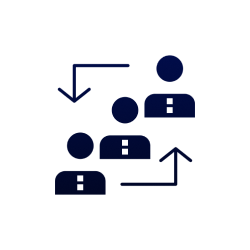
Have you found a new ERP package? And do you want to benefit from efficiency gains, improved insight, and cost savings of your brand-new software as soon as possible?
Then you want to avoid failure of your implementation process at all costs. Did you know that around 75% of implementations fail partially or even completely?
This article offers valuable tips to help you succeed in your ERP implementation!
You will also discover how to get a new ERP up and running in just 3 concrete steps. In addition, you will get advice that will save you thousands of euros.
Go through the steps, use our advice and make a success of your implementation!
* This article is written in collaboration with ERP implementation partner ABC E BUSINESS. ABC E BUSINESS, with their experienced consultants, has performed over 250 successful implementations. With a focus on SMEs. We conducted a 50-minute interview with Lars Hoving (CEO). This aimed to create an extra valuable (and expert-rich) article for you!
Contents of this article:
An ERP implementation is the process of installing ERP software within an organization.
The system is then prepared for use. In this process, the system is configured and/or customized based on the organization's specific situation. An implementation includes things like: migrating data within a single system, training staff and setting up the software so that it can go live.

It is important to evaluate if your current system still meets your needs.
On average, there is a new "measuring moment" after 7 years. During this moment, you determine whether you need new software. In some cases, upgrading your package is sufficient.
Some situations in which you could use a new system. Who knows, maybe you recognize yourself in them!
And? Do you recognize yourself in one or more situations? Then we think it's high time for a (new) ERP! Click here to learn more on whether you should buy a new ERP package.
Want to discover which partners and systems suit you within 5 minutes? Fill in some questions about your situation and see which party is your best match:
Want more information on how to select the right ERP system? Watch ABC E BUSINESS their video and find out!
Curious about what an implementation looks like in concrete terms? Below we walk through three simple steps.
This roadmap is a practical example of how coauthor ABC E BUSINESS performs an implementation.
Other partners may of course have a different process. Already read several articles on this topic? Then you may notice that other parties often name more than three steps.
Let's keep it as simple as possible for now.
During an intake, you make your needs known to your ERP partner. It is always good to first know why you want to use an ERP.
Identifying your needs is, in most cases, completely in the hands of sales. This is where the sales department tries to surface your needs and wants as completely as possible.
Expect them to fire these kinds of questions at you:
The above questions will help your partner prepare an appropriate quote. You want to avoid missing or unnecessary items in the quotation.
"A common challenge is differences in understanding between the customer and supplier. Miscommunication can lead to situations where certain functionalities are not included in the quotation, but are expected by the customer. It is important to address these misunderstandings on time and provide clarity on what is and is not included in the offer."
Want to get off to a good start right away? Then make sure you have a good understanding of your current processes and requirements. A good start is half the battle!
Your needs are now in black and white (or in a digital document). You will then receive an advisory report and a quotation.

Now it's time for implementation, step 2 within the process.
During an implementation, you normally start by setting up your system. Together with your ERP partner, you make sure your processes are transferred correctly. Together, you will ensure that everything is properly set up in your new software.
Now it's time to test if everything is correct!
Is everything 100% correct? Then that's it: The software can go live and is ready to use!
Going live with a new ERP is complex. Supportive training and support are essential during (and after) implementation.
Most ERP partners therefore offer training courses. During these courses, you learn how to work with the system.
You will also often receive support from your ERP partner. There are always issues that arise during the process. It sometimes happens that someone, despite the numerous hours of training, spontaneously forgets how to book a sales invoice!
And that people spontaneously forget how to book a purchase invoice or book a sales invoice, even though they have all had training for that.
By the way, we recommend that you choose a vendor with knowledge of your industry. This will ensure that your subject matter questions are adequately answered.

Here are five tips that will increase your chances of a successful implementation:
A lack of support is reason #1 for failed implementations. But how do you ensure the much-needed support of your employees?
To achieve this, we advise you to include your key users (people who will use the ERP the most) in the process from minute one.
"I've been doing this this way for 20 years, why does it suddenly have to be different now?"
But why does this work so well? Including end-users makes people feel heard. You also want to take their input seriously.
How would you personally feel if your boss told you that you had to log into system X from now on? Without giving you additional context on this?
You (or someone else) makes the choice, but users provide input during the selection process.

Don't think of your vendor as a "supplier," but really as a partner. You simply have to get along well.
Cooperation is like a marriage. You all quarrel from time to time, but you have to make up for it. This is only possible if you really see the supplier as a partner. That is really the most important thing.
"But how can I know if I have a "click" with a potential partner?" I hear you thinking.
Some concrete tips from us:
Use the tips and find your perfect match. When doing so, listen to your gut and don't just focus on the business aspect.
Increase your chances of choosing the right partner for your project? Get more explanation on this tip on our comprehensive page on finding an ERP partner.

Want the smoothest implementation process possible? Then it is essential to have your "homework" in order.
By "homework" we mean that you must have a clear picture of where your needs lie. So don't go looking for an ERP implementation partner blankly, but first know why you are looking for a (new) system.
Do you not properly identify your needs? Then you run the risk of a difficult implementation. This is not pleasant for you, but it is certainly not ideal for your partner either.
Do you have a good understanding of your needs? Then you increase the chance that your ERP will fit seamlessly with your business processes.
We often see organizations tailoring the software to their own processes. Do you choose this option? Then additional time will need to be set aside to build these additional features into your software.
Keep in mind that the cost per hour is over 100 euros!
Therefore, we recommend that you always adjust your processes, and not completely overhaul the software.
Sometimes it is simply easier to make small adjustments to your processes than to modify the entire ERP system.
It is important to look critically at your business processes and evaluate whether your process makes sense. Maybe your processes are not as logical as you always thought after all!

Appointing a project leader increases the likelihood of a smooth implementation.
Why this is so? A project leader ensures that the tasks, which arise from your ERP partner's visits, are taken care of.
An internal project leader is the link between the ERP partner and management. This person ensures that the necessary time is released.
In fact, we often see that organizations, in addition to their normal business operations, have too little time left over for an implementation. Logical! After all, everyone is busy enough without a complex implementation.
Hence, once again our advice (because we think this is so important): always appoint an internal project leader!
An implementation takes at least 3 months in most cases. Remember that an implementation process's duration depends on many factors.
Here are the determining factors:

The cost of the implementation process depends on many factors. Unfortunately! No single answer to this pressing question can be given.
Luckily, we can give you the following indication regarding the costs of an ERP implementation. Let's take a simple example:
This will result in the following implementation costs. These are based on whether you pick a simple, advanced or complex system. Remember that this is just an indication of your actual costs.
*The complexity of your chosen software strongly determines your costs. The more complicated your system, the higher your implementation costs.
Go to the calculator and fill in YOUR specific revenue and the complexity of your software of choice. This will finally give you a good indication of your implementation and license costs.
Finding a suitable partner for your ERP project is not easy.
The perfect ERP partner does not exist. In our opinion, the choice is very subjective. Every company needs a different supplier.
Want to discover which party is the best fit for you? Fill out our comparison tool and find out within 5 minutes.
Based on your situation and needs, our tool will match you with a suitable partner. Find out now who is your perfect match.
Would be fun to see ABC E BUSINESS coming out as the winner!
Find your perfect ERP-system